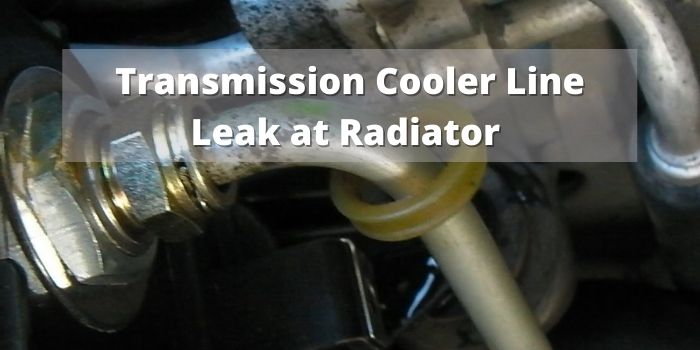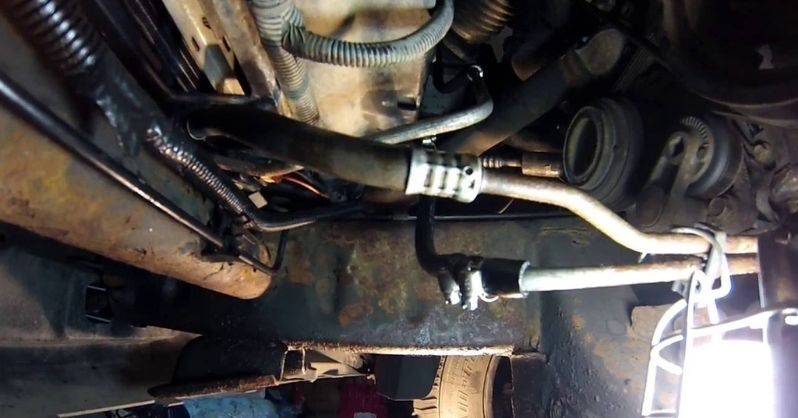The transmission is an integral part of your car as it allows you to control the car and properly drive it. If problems occur with the transmission, you won’t be able to use your car properly. One of the common issues every driver needs to be aware of is transmission cooler line leak at radiator.
So we’ll be looking at what transmission cooler lines are and what can cause them to leak. After that, we can go on to see how you can fix or solve the issue of your cooler lines leaking.

What Is Transmission Cooler Line?
Changing the transmission changes the gears in your car. To ensure a smooth transition, a lubricant is used. This lubricant ensures smooth motion of the gears as well as acts as a coolant to make sure the gears don’t overheat and get damaged.
To obtain the cooling property, lines from the transmission go to the radiator. This cools down the fluid, which then passes to gears and lubricates them for smoother transmission. As you can see, transmission cooler lines are incredibly important to ensure your car works smoothly.
These cooler lines can get worn out with time or can have tears in them. This can result in fluid not being properly transported. When this happens, your transmission gears might not respond and can end up overheating.
Types Of Transmission Cooling Lines

Transmission cooling lines usually vary based on what material is used to construct them. There are usually four commonly seen types you’ll come across. These are:
Metal
Metal transmission lines have a fixed shape and size. As a result, they are limited to specific applications. However, they are quite strong and resistant to wear. They also have a high melting temperature, so they won’t be damaged by the surrounding heat.
They usually see use in factories where their fixed shape and size isn’t much of an issue. A higher melting temperature is often required due to the excessive heat some factory production can cause.
Rubber
Rubber transmission lines trade strength for flexibility. It is easier to adjust the shape and fit it around objects. Due to this, rubber transmission lines do find use in cars, connecting various parts of the engine to allow the proper fluid transfer. It’s also easier to fit multiple lines in an enclosed space since you can move the pipe around obstacles, and they tend to be much cheaper than metal ones.
However, rubber lines are vulnerable to getting damaged, and in high heat situations, they can end up melting. As a result, rubber transmission lines need a good deal of maintenance and often need to be replaced at times.
Nylon Braided
Nylon braided transmission lines are seen as an upgrade to rubber ones. They have an additional nylon layer which provides greater protection from wear and tear. As a result, they cost a bit more than your usual rubber lines, but they tend to have a much greater life span and don’t need to be replaced as much.
Steel Braided
Steel braided transmission lines tend to be the most expensive but also the most resilient. These tend to be somewhat flexible but not to the same degree as rubber or nylon braided ones. Due to how strong they are, they are used in heavy-duty tasks and where you can’t afford to replace the lines from time to time.
Either nylon braided or rubber transmission lines see use in automobiles. The other two are not used due to the costs and implementation difficulties involved.
How To Know If Coolant Lines Are Leaking?
There are some signs that you should be aware of to know if the coolant lines are leaking or not. Leaving the problem unchecked can be quite dangerous and lead you to incur more repair costs, so it is best to identify it as soon as you can: The possible symptoms of a coolant line leaking are:
Pools Of Fluid
If a coolant line is punctured or damaged, the coolant can leak out. It is possible to see puddles form from the dripping coolant. A red liquid dripping out near the radiator of your car is a tell-tale sign that there is a transmission cooler line leak. Look for any stray liquid dripping out before you take your car out to drive.
Using a white paper or towel will help provide better contrast. This can help you identify what fluid is leaking, so make sure to carry a white towel around.
Burning Smell
This symptom often appears during more extreme cases. If you’ve been driving on low fluid levels for a while, your gearbox will start to overheat. When this happens, you may pick up on a burning smell. You need to take action in this case quickly.
Indicators
Some cars have built-in indicators or alarms notifying you when your transmission coolant has gone down a certain level. Usually, the check engine light is one such indicator. It is a good practice to also go over and check the dipstick to ensure it is not a false alarm.
Odd Sounds And Difficulty Shifting Gears
The transmission coolant is needed to ensure lubrication of the gears in your car. This, in turn, allows you to shift gears with ease. However, with a low coolant level, you might start to notice difficulty with changing gears and general unresponsiveness.
This unresponsiveness can be occupied by grinding noises. If you hear such noises while changing gears, it is a strong sign that there might be a coolant leak. Also, you might experience delay in throttle response.
Cracks On The Coolant Lines
This one might be a bit harder to spot since the coolant lines are located under your car. If your coolant level is low, the transmission lines will heat up, and this can lead to the coolant lines expanding or deforming. If you notice dents or cracks on the cooling lines, it is safe to assume there is a leak and that your car has incurred serious damage.
Transmission Cooling Lines Replacement Costs
There is a fair bit of variance since it will depend on the extent of damage and your car’s model. In general, it will cost you anywhere from 150 to 350 dollars. This does not take into account additional labor costs since it will depend on the shop you get the replacement from. In extreme cases, you might have to spend more than 500 dollars.
How To Fix Transmission Line Leak At Radiator
If a transmission line is leaking, it is probably because the line has been worn out or damaged. You can attempt to patch it up, but this is a temporary fix. The best option to fix it is to simply replace the damaged line with a new one.
Make sure to clean the engine off any leaked fluid before you go to replace the damaged lines. Leaked fluid can end up corroding parts of the engine and also damage any new transmission lines you install.
Conclusion
Hopefully, after reading this article, you understand better how to handle a transmission cooler line leak at radiator. It can spiral into a big issue, so you must always be attentive to the particular symptoms and take quick action to minimize damage.